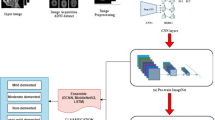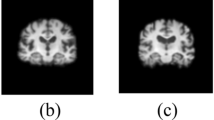Abstract
Dementia is collection of traits that are linked with a reduced memory power, thinking abilities or other cognition-related skills. Dementia exists in many different forms and can be caused by many different conditions. However, the most common cause of dementia is Alzheimer’s. Alzheimer’s can be described as one specific disease (Beer et al in The Merck manual of diagnosis and therapy. Merck Research Laboratories, 1999 [1]). In recent years, many deep learning approaches to classify brain images with respect to the Alzheimer’s disease are being proposed, and a tremendous amount of research is being done in this area. However, these approaches are still not being used actively in the medical field due to apprehensions about their accuracy and due to a general lack of appropriate medical data. This paper aims at introducing an approach to classify the Alzheimer’s MRI image data into four different stages. The approach produces efficient and accurate results and is designed to encourage the implementation of deep learning in day-to-day medicine without the need for much human involvement. In the proposed method, we use transfer learning to employ three pre-trained deep learning models to perform the task of classification and combine them through a stacked ensemble, which can then be used for the purpose of predictions. To carry out this approach, the Alzheimer’s data set (four classes of images) from Kaggle, containing MRI brain images, has been used, and the proposed methodology has produced an accuracy of 97.8%. The results have been visualized and presented in this paper.
Access this chapter
Tax calculation will be finalised at checkout
Purchases are for personal use only
Similar content being viewed by others
References
Beers MH et al (1999) The Merck manual of diagnosis and therapy. Merck Research Laboratories
Breijyeh Z, Karaman R (2020) Comprehensive review on Alzheimer’s disease: causes and treatment. Molecules 25(24):5789
Toshkhujaev S et al (2020) Classification of Alzheimer’s disease and mild cognitive impairment based on cortical and subcortical features from MRI T1 brain images utilizing four different types of datasets. J Healthc Eng 2020
Bae JB et al (2020) Identification of Alzheimer’s disease using a convolutional neural network model based on T1-weighted magnetic resonance imaging. Sci Rep 10(1):1–10
Yamanakkanavar N, Choi JY, Lee B (2020) MRI segmentation and classification of human brain using deep learning for diagnosis of Alzheimer’s disease: a survey. Sensors 20(11):3243
Zhang J et al (2021) A 3D densely connected convolution neural network with connection-wise attention mechanism for Alzheimer’s disease classification. Mag Resonance Imaging 78:119–126
Tian J et al (2021) Modular machine learning for Alzheimer’s disease classification from retinal vasculature. Sci Rep 11(1):1–11
[Online]. Available: https://www.kaggle.com/datasets/tourist55/alzheimersdataset-4-class-of-images
Sun Q et al (2019) Meta-transfer learning for few-shot learning. In: Proceedings of the IEEE/CVF conference on computer vision and pattern recognition
Sollich P, Krogh A (1995) Learning with ensembles: how overfitting can be useful. In: Advances in neural information processing systems, vol 8
Zhou Z-H (2012) Ensemble methods: foundations and algorithms. CRC Press
Wolpert DH (1992) Stacked generalization. Neural Netw 5(2):241–259
Author information
Authors and Affiliations
Corresponding author
Editor information
Editors and Affiliations
Rights and permissions
Copyright information
© 2024 The Author(s), under exclusive license to Springer Nature Singapore Pte Ltd.
About this paper
Cite this paper
Madhumitha, T., Nikitha, M., Chinmayi Supraja, P., Sitakumari, K. (2024). Classification of Alzheimer’s Disease Using Stacking-Based Ensemble and Transfer Learning. In: Malhotra, R., Sumalatha, L., Yassin, S.M.W., Patgiri, R., Muppalaneni, N.B. (eds) High Performance Computing, Smart Devices and Networks. CHSN 2022. Lecture Notes in Electrical Engineering, vol 1087. Springer, Singapore. https://doi.org/10.1007/978-981-99-6690-5_13
Download citation
DOI: https://doi.org/10.1007/978-981-99-6690-5_13
Published:
Publisher Name: Springer, Singapore
Print ISBN: 978-981-99-6689-9
Online ISBN: 978-981-99-6690-5
eBook Packages: Computer ScienceComputer Science (R0)




